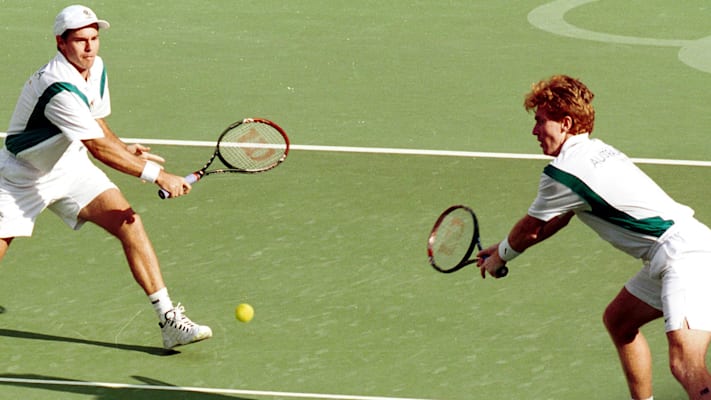In the annals of tennis history, few partnerships have left as enduring a mark as the Australian duo of Todd Woodbridge and Mark Woodforde—better known as The Woodies. Their decade-long dominance in men’s doubles redefined the art of partnership, setting unmatched standards for consistency, excellence, and sportsmanship.
Born on April 2, 1971, in Sydney, Todd Woodbridge was a tennis prodigy with dreams of Wimbledon glory and Davis Cup duty. While he had a solid singles career—peaking at world No. 19 and making the Wimbledon semifinals in 1997—his genius truly flourished in doubles. Quick reflexes, superb volleying, and an astute court sense made him a fearsome net presence.
Mark Woodforde, six years senior and born in Adelaide on September 23, 1965, was a steady left-hander whose baseline consistency and calm demeanor made him an ideal partner. Though he won four ATP singles titles and reached the 1996 Australian Open semifinals, like Woodbridge, his legacy was forged in doubles. He rose to world No. 1 in doubles in 1992, praised for his adaptability and strategic mind.
Their partnership began in the early 1990s and soon evolved into one of the most complementary and successful alliances in sports. Woodforde’s baseline control and left-handed angle meshed seamlessly with Woodbridge’s dynamic net play. Off-court, their personalities clicked too—Woodforde the calm anchor, Woodbridge the energetic spark. It was a balance that not only brought titles but helped them survive the mental grind of elite tennis.
Together, the Woodies won 11 Grand Slam men’s doubles titles—a record unmatched until the Bryan brothers equaled it in 2011. Their major triumphs included:
- Wimbledon: 6 titles (1993–1997, 2000)
- US Open: 2 titles (1995, 1996)
- Australian Open: 2 titles (1992, 1997)
- French Open: 1 title (2000)
Their reign at Wimbledon was historic—they remain the only men’s team in the Open era to win five consecutive titles there and hold the record with six overall.
In total, they captured 61 ATP doubles titles as a team, were named ATP Doubles Team of the Year five times, and held a 508–137 win-loss record. Woodforde retired with 67 career doubles titles, while Woodbridge finished with 83, including wins with other partners.
Together, the Woodies won 11 Grand Slam men’s doubles titles—a record unmatched until the Bryan brothers equaled it in 2011. Their major triumphs included:
- Wimbledon: 6 titles (1993–1997, 2000)
- US Open: 2 titles (1995, 1996)
- Australian Open: 2 titles (1992, 1997)
- French Open: 1 title (2000)
Their reign at Wimbledon was historic—they remain the only men’s team in the Open era to win five consecutive titles there and hold the record with six overall.
In total, they captured 61 ATP doubles titles as a team, were named ATP Doubles Team of the Year five times, and held a 508–137 win-loss record. Woodforde retired with 67 career doubles titles, while Woodbridge finished with 83, including wins with other partners.
The Woodies brought Olympic glory to Australia with gold at Atlanta 1996—the nation’s only Olympic tennis gold—and a silver at Sydney 2000, their swansong. These accolades elevated them to national hero status and cemented their legacy beyond the tour.
In the Davis Cup, the duo became a pillar of Australia’s resurgence. Their most crucial contribution came in 1999, when they won the doubles rubber in the final against France, helping Australia lift the trophy after a 13-year drought. Their 14–2 Davis Cup record as a pair reflects their dependability under pressure.
In the Davis Cup, the duo became a pillar of Australia’s resurgence. Their most crucial contribution came in 1999, when they won the doubles rubber in the final against France, helping Australia lift the trophy after a 13-year drought. Their 14–2 Davis Cup record as a pair reflects their dependability under pressure.
The Woodies’ magic lay in their contrasting yet complementary styles. Woodforde’s left-handed baseline play controlled rallies, while Woodbridge’s net aggression finished points. Their tactical poaching, instinctive positioning, and fluid communication became a blueprint for modern doubles.
Temperamentally, too, they were a study in harmony—Woodforde’s composure offset by Woodbridge’s fiery motivation. That chemistry allowed them to ride highs and endure lows, a critical asset in high-stakes matches.
Their success helped revolutionize doubles strategy, especially in how handedness and team roles were utilized. Their matches were not just wins—they were masterclasses in doubles technique and team dynamics.
The Woodies’ legacy has inspired generations, including the Bryan brothers, who cited them as their childhood idols. Though the Bryans eventually overtook them in overall titles, the Woodies’ Olympic success and Wimbledon dominance remain uniquely Australian.
They are often mentioned alongside great duos like McEnroe/Fleming, Newcombe/Roche, and Sedgman/McGregor. Yet their longevity, adaptability across surfaces, and career Grand Slam set them apart. Few teams have been as complete.
Post-retirement, both continued serving the sport. Woodforde turned to coaching and commentary, including stints with the Australian Fed Cup team. Woodbridge became a respected media figure and tennis analyst, offering insights shaped by years at the top.
Their accolades are many: induction into the Australian Tennis Hall of Fame in 2010, bronzed statues at Melbourne Park, and the Philippe Chatrier Award from the International Tennis Federation in 2014. Both received the Medal of the Order of Australia for their services to sport.
The partnership officially ended with Woodforde’s retirement in 2000. Woodbridge went on to win more majors, notably with Jonas Björkman. Yet the “Woodies” era remains a golden chapter in tennis history.
Their story isn’t just about numbers. It’s about how they played—with grace, unity, and a relentless pursuit of excellence. They redefined what a doubles team could be and set a standard that still shapes the sport today.
Todd Woodbridge and Mark Woodforde will always be remembered not only as champions but as torchbearers for the art of partnership in tennis. Their influence echoes in every successful doubles team that prioritizes communication, chemistry, and commitment over mere talent.
For Australia, for tennis, and for sport itself, the Woodies were more than a team. They were a phenomenon.








